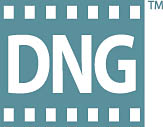
 |
| Home • Reviews • Forums • News 2015 • 2013 • 2012 • 2009 • 2008 • 2007 • 2006 • 2005 • 2004 RSS Feeds • FOV Factor Table • Sensor Sizes | Definitions: A-D • E-H • I-L • M-P • Q-U • V-Z | Sitemap Articles • Archived Websites (Pre-DigitalDingus): D100 Lounge • E-10 Club | Contact |
| Adobe DNG |
| September 27, 2004 |
| SAN JOSE, Calif. --(Business Wire)-- Sept. 27, 2004 Free Converter Tool Kick Starts New Digital Negative File Format by Translating Raw Formats into Easy-to-Use, Archive-Ready Files
Adobe Systems Incorporated (Nasdaq:ADBE) today introduced the Digital Negative Specification, a new unified public format for raw digital camera files. The company also launched a free software tool, Adobe DNG Converter, which translates many of today's popular raw photo formats into the new .DNG file format, compliant with the Digital Negative Specification. Raw files, which contain the original information captured by a camera sensor prior to any in-camera processing, have become popular due to their promise of greater flexibility and image quality. Until today there has been no standard format for these files, which vary between manufacturers and individual cameras. The Digital Negative Specification solves this problem by introducing a single format that can store information from a diverse range of cameras. Technology leaders, major customers, and professional photographers today also endorsed the new specification (see separate quote sheet). "Professional photographers and other creative professionals are moving to raw camera workflows because of the outstanding creative control they get over digital images," said Bryan Lamkin, senior vice president of Digital Imaging and Digital Video products at Adobe. "However, clients and publishers have difficulty working with disparate raw file formats and nobody can be sure that today's raw formats will be supported ten years from now. Adobe customers asked us to work on a unified, public format for raw files and that's what we've delivered with the new Digital Negative Specification." Serious photographers want to store raw files in long-term image archives, because -- unlike standard JPEG's and TIFF's -- these files represent the pure, unaltered capture. Current raw formats are unsuitable for archiving because they are generally undocumented and tied to specific camera models, introducing the risk that the format will not be supported over time. The unified and publicly documented Digital Negative Specification ensures that digital photographs can be preserved in original form for future generations. The new .DNG file format also simplifies digital imaging workflows for creative professionals who today have to juggle multiple file formats as they bring raw images, from different cameras, into print and cross-media publishing projects. New Specification Built on Existing Standards The Digital Negative Specification is based on the TIFF EP format, an accepted standard, and already the basis of many proprietary raw formats. The power of .DNG format lies in a set of metadata that must be included in the file to describe key details about the camera and settings. .DNG-compliant software and hardware can adapt on the fly to handle new cameras as they are introduced. The new file format unifies conflicting raw formats, enabling the preservation of a pristine version of the original raw image and the metadata associated with it. .DNG is also flexible enough to allow camera manufacturers to continue to add their own "private" metadata fields. The Digital Negative Specification is being posted to the Adobe Web site free of any legal restrictions or royalties, enabling integration of the .DNG file format into digital cameras, printers, and software products. By adopting .DNG, camera manufacturers eliminate the need to develop new formats, simplify product testing and ensure new cameras have a raw format immediately compatible with tools such as Adobe Photoshop CS and Adobe Creative Suite. The .DNG format is immediately supported in Adobe Photoshop CS as part of an updated Camera Raw Plug-in, also introduced today (see separate release). Adobe Photoshop Elements 3.0 also supports .DNG files. DNG Converter Available Today Kick-starting the adoption of .DNG, Adobe DNG Converter is available today as a free download at: http://www.adobe.com/dng. This translates raw formats from more than 65 cameras, including recent models such as Canon PowerShot S60, Epson RD-1, Fujifilm FinePix S20 Pro, and Nikon Coolpix 5400, into the new .DNG file format. About Adobe Systems Incorporated Adobe helps people and businesses communicate better through its world-leading digital imaging, design and document technology platforms for consumers, creative professionals and enterprises. Adobe's revenue in its last fiscal year exceeded $1.2 billion. For more information about Adobe, http://www.adobe.com. (C) 2004 Adobe Systems Incorporated. All rights reserved. Adobe, the Adobe logo and Photoshop are either registered trademarks or trademarks of Adobe Systems Incorporated in the United States and/or other countries. All other trademarks are the property of their respective owners. |
| Major Features |
|
| Home • Reviews • Forums • News 2015 • 2013 • 2012 • 2009 • 2008 • 2007 • 2006 • 2005 • 2004 RSS Feeds • FOV Factor Table • Sensor Sizes | Definitions: A-D • E-H • I-L • M-P • Q-U • V-Z | Sitemap Articles • Archived Websites (Pre-DigitalDingus): D100 Lounge • E-10 Club | Contact |